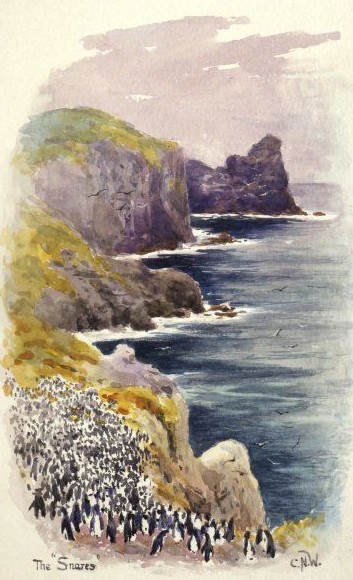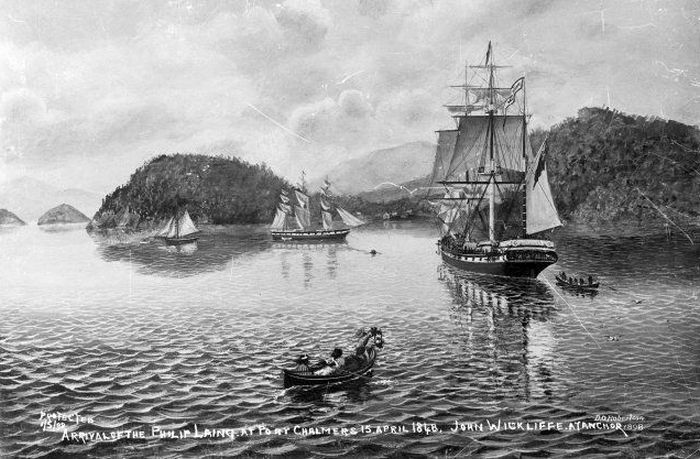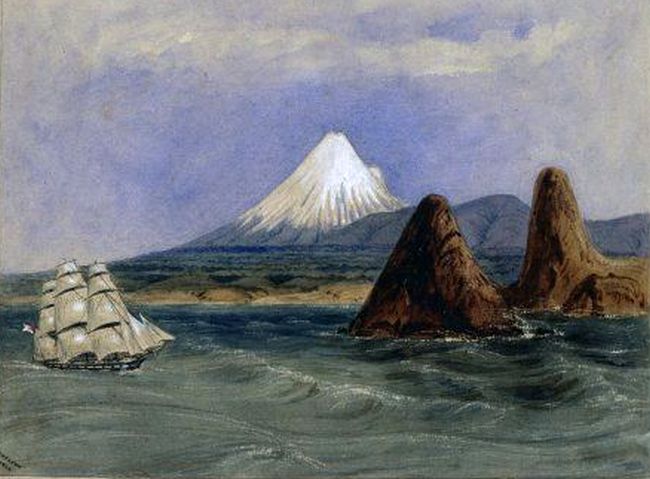After all the packing was completed my
grandfather Charles Hursthouse; Aunt Mary Hursthouse; my mother and father
and Nora, Ida, Frank, and Harry all proceeded up to London and secured
lodgings... After staying at Walton some time, Aunt Rachael took me up to
London to the rest of the family, visiting Peterloo Cathedral on the way.
The elders had a very busy time there purchasing an outfit for the new
life before us, for very little could be procured in the colony at that
time, Passages had been taken in the ship Pekin under Captain Whitby, a
vessel of about 600 tons...
She was lying in the London docks and here we used
to go every day to fit up the cabins... Mr George Curtis and his wife
Eliza (nee Newsham) along with their children George, Ida and Helen had
also succumbed to my uncle's persuasions, and embarked with
us.
All being ready for our voyage, the ship dropped
down the Thames to Gravesend where we joined her after going down the
river in one of those little steam tugs. Those who came to see us
off were Miss Richmond; Miss Akinson (afterwards Mrs C W Richmond);
C W and James Richmond, their mother, Mrs Rlcnmond; and Aunt
Rachael. After we parted from our friends, the ship again dropped down the
river but brought up in the Downs because the wind was against us. This
was 9th August 1849 ... For a whole fortnight we had to beat down channel
against a southwest wind, being close to the coast of France each evening
and on the coast of England every morning. However, we eventually got a
fair wind and proceeded on our voyage.
We had a considerable number of passengers on
board for various ports in New Zealand and among them was Dr Muller the
ship's surgeon, his wife and his children... Mrs Muller died on the
voyage. I remember she was sewn up in a hammock and dropped over the side
after the Captain had read the service for those buried at sea. Dr Muller
settled at Blenheim where he was for many years Resident
Magistrate. Another of our passengers was a Mrs Griffiths with her
two children and she afterwards married Dr Muller.
In those days there were apparently pirates
still plying their trade in the Atlantic, for on one occasion great alarm
was experienced pn our ship due to another ship which was apparently
chasing us, but the Pekin easily out-sailed her and, indeed, any other
craft we came across.. .
I am astonished now when I think of it, how our
parents could possibly have allowed us to do the risky things we did.
George Curtis, Eugene Muller and I (both of them a little younger than me)
used to climb to the tops of the m~ts and it ~as considered the proper
thing to do to clap one's hand on the truck at the top of the mast. Even
Ida Curtis, who could not have been more than seven years old, used to go
up to the main-top. On one occasion, when some of us were chasing her, she
slid from the main-top, along the stay of the main-staysail right down to
the foot of the main mast, much to the detriment of her hands and clothes,
for she got covered with grease.
In the South Indian Ocean it was a great amusement
to everybody to catch albatross which was a cruel proceeding for it
was done by hook and line. Many of the beautiful little cape pigeons were
also caught, but this was done by letting a frayed line float from the
stern of the ship, in which they got
engangled. 
We fIrst sighted the New Zealand coast at the
Snares Islands, south of Stewart Island, and from there ran up the coast
to Otago, arriving at Port Chalmers on 5th December 1849. I can remember
well as we drew into the bay outside Otago Heads, after passing Cape
Saunders, the excitement of everybody on again seeing land so close... and
this excitement was increased when we saw a whale boat approaching in
which were Captain Driver and his crew of four Maoris. The pilot had
brought off a supply of fresh bread, butter and meat, and we all thought
the bread and butter the most delicious food we had ever
eaten.
After crossing the bar we had to anchor for
the tide just opposite a large Maori village prettily situated under the
wooded hills, with a white beach in front, on which were lying a number of
canoes. When we anchored at Port Chalmers, we found two other ships lying
there... both of which had brought emigrants for Otago from Scotland...
Port Chalmers was not then a very large place: as a matter of fact there
were only four houses, three of which were public houses. The hills rose
immediately behind the houses and were covered with dense forest through
which, along a hollow that the railway now follows, a sledge track about
ten feet wide had been cut to Sawyer's Bay, and thence on to
Dunedin;
Worsley, Charles Nathaniel,
1862-1923 :The "Snares". [Jan 1902].Shows a colony of penguins standing on
the cliffs of a precipitous coastline with several inlets
The New Zealand Company's agent at that
time was Mr Walter Mantell, who came off and arranged to send quantities
of fresh provisions, which needless to say we enjoyed very much, after the
diet of preserved milk and meat, and biscuits on which we principally
lived during the voyage.
My father and Mr Curtis walked up to the embryo
,town of Dunedin from Port Chalmers and on their return described the
terrible state of the road - or track - owing to the mud they had had to
pass through on the way. There was a pretty little bay about a mile east
of Port Chalmers... through which a nice little stream fell into the
harbour. To this place, many of the women passengers took all the dirty
clothes that had accumulated during the voyage to have a grand washing
day. Emma Francis, whom we had brought with us from our lodging in
London as a servant whose duty it was to nurse my brother Harry,
undertaking our part .

Photograph of a painting depicting the
arrival of the Philip Laing at Port Chalmers, 15 April 1848, with the John
Wickliffe at anchor. The painting is by David Ogilvie Robertson;
photographed by David Alexander De Maus in 1898. Original painting at the
Otago Settlers Museum.
After a stay of about a fortnight at
Port Chalmers we sailed on up the coast, passing the place where
Lyttelton and Christchurch are now, on Christmas day. Neither of
these towns had been founded at that time and I believe there was only one
white man - Deans - living near the present site of
Christchurch.
On 26th December we arrived at Wellington which,
at that time, was also a very small place - the houses extending along the
beach from near Thomdon to Te Am and a little pier where passengers
landed, just where the Government Printing Office now is. There was a kind
of rough road running along high water mark, dignified with the name of
Lambton Quay. Part of Thomdon flat was still under forest as were
the whole of the Tinakori Hills.
Heaphy, Charles:Port
Nicholson from the hills above Pitone in 1840 Identifies Hutt River, Somes
Island, Evans Bay and Wellington. Shows the huts of the first
settlers at Petone. View of western hills looking out towards the harbour
entrance.
Whilst there my father and Mr Curtis decided to
walk overland to New Plymouth - some 250 miles, rather an undertaking for
people who had just come off a long sea voyage. As a matter of
fact they did not accomplish the journey on foot after all but
having got as far as Rangitikei they found themselves so footsore that
they had to buy two horses for the further prosecution of the journey...
After a good many adventures they arrived safely at New Plymouth and were
able to make arrangements for the housing of the family on our arrival by
sea.
We left Wellington on 13th January 1850 and after
two or three days knocking about in Cook Strait reached Nelson. We left
Nelson on 3rd February and as we passed down the channel saw the ship
Berkshire miss stays and go ashore on the boulder bank where, it is said,
she broke her back. W e were however almost as unfortunate, for we
ran ashore on the opposite bank of the channel and there laid in the mud
until the next high tide enabled us to get off. I remember the ship laid
over so much that it was difficult to walk on the deck. It was shored up
by several spars thrust over the side into the mud and made fast at the
upper ends to the vessel. While lying in the mud, i hooked a large shark
(eight feet long) which the sailors pulled

Artist Charles
Heaphy: 1849 - view from the sea with a three-masted barque, possibly to
represent the Tory. The Sugar Loaf Islands and volcanic peak Paritutu in
right foreground and Mount Egmont and foothills in the
background.
We had no further adventures
and finally dropped anchor in the old anchorage at New Plymouth on 7th
February 1850. My father came off in one of the old-fashioned surfboats to
meet us, and unfortunately got one of his hands badly crushed between the
ship and the boat. Thus ended our long voyage of two days under six
months. It was altogether a pleasant experience for a boy like me and I
learnt a good deal about ships etc. which has always remained with
me, together with a fondness for the sea.